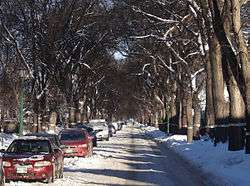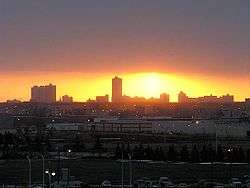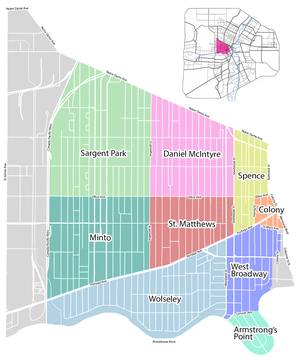West End, Winnipeg
The West End is a mostly residential area of Winnipeg, Manitoba, Canada. It is bordered by Route 62 (Osborne, Memorial, Colony, and Balmoral Streets) on the east, St. James Street on the west, the Assiniboine River on the south, and Notre Dame Avenue on the north. It includes the neighbourhoods of Armstrong's Point, Colony, Daniel McIntyre, Minto, Sargent Park, Spence, St. Matthews, West Broadway, and Wolseley.
Demographics

In 2011, the population of the West End was 46,140.[1]
The area is ethnically diverse. 2011 census data shows the West End as 51% Caucasian, 21% Filipino, 15% Aboriginal, 4% Black, and 9% other visible minorities.[1] Historically, the area was home to large German, Scandinavian, and Icelandic communities.
Contrast between neighbourhoods in the West End is extreme. Armstrong's Point is one of Winnipeg's most affluent neighbourhoods with a median household income of $89,887. West Broadway is located directly north of Armstrong's Point, and has a median household income of $25,877.[1]
Politics
Municipally, the West End is within the Daniel McIntyre and Fort Rouge/East Fort Garry city council wards and is represented by Cindy Gilroy and Sherri Rollins respectively.[2]
Provincially, the electoral map of the Manitoba was redrawn in 2019.[3] The West End is now divided into the following four electoral districts: Wolseley (Lisa Naylor, NDP), St. James (Adrien Sala, NDP), Notre Dame (Malaya Marcelino, NDP), and Union Station (Uzoma Asagwara, NDP).[4]
Federally, the West End is within the Winnipeg Centre electoral district and is represented by Leah Gazan (NDP).[5]
History

The development of the West End as a residential expansion came during one of Winnipeg's largest periods of growth between 1890-1895 and 1900-1912.[6] The area was originally a part of the Parish of St. James until the boundary of the City of Winnipeg was extended to St. James Street from Maryland Street (formerly Boundary Road) in 1882. Development of the area as a working and middle class residential area began in the late 19th century and continued through the 1920s until the area was completely built up. The area developed rapidly due to its proximity to Downtown Winnipeg, and, unlike Winnipeg's North End, the mainline of the Canadian Pacific Railway did not impose a physical barrier between the West End and Downtown. The area was also well served by the city's street railway system with lines on Portage Avenue, Sargent Avenue, Sherbrook Street, and Arlington Street. The industrial area located adjacent to the railway spur between Wall and Erin Streets provided employment for many West End residents.
The West End was considered Ward Two in the Old City of Winnipeg and was seen as the "swing riding" between the affluent and conservative Ward One and overwhelmingly socialist Ward Three, which comprised the North End and Elmwood.
Valour Road, the residence of three recipients of the Victoria Cross in World War I, is located in the West End.
Parts of the area declined in the years following World War II as many families moved to Winnipeg's suburbs and some of the housing stock was converted to rooming houses and became dilapidated. During the 1970s, crime became a serious problem in portions of the West End.
Since the 1980s, a notable revitalization of the neighbourhoods has been made. Numerous urban beautification projects have been undertaken and in 1987, The West End Cultural Centre was founded in an old church at Ellice Avenue and Sherbrook Street. The venue attracts 30,000 people a year to various events, mostly musical shows. The importance of a healthy and vibrant West End to the future success of Downtown Winnipeg has also been recognized.
Much of the West End has experienced a sharp renaissance in recent years. Between 2000 and 2011, average home price in the West End shot up much more quickly and drastically than Winnipeg's average. West End homes rose 361% in value,[7] whereas the city of Winnipeg average home price rose 272% in that same time-frame.[8]
Amenities
The commercial area in the Polo Park district has expanded rapidly beginning in the 1990s with the building of big-box retail outlets, restaurants, and a major hotel. It has now supplanted Downtown Winnipeg as the city's main commercial area. The Polo Park area was once home to the Winnipeg Arena and Canad Inns Stadium.
Attractions in the area include, the University of Winnipeg, Vimy Ridge Memorial Park, Omand's Creek and Park, Westview Park, and the Sargent Park Recreation Complex, as well as many houses, apartment buildings, schools, and an armoury with significant architectural merit. Portage Avenue is the site in the summer months of the "Sunday Night Cruise" by automobile enthusiasts, which while delighting the participants, raises the ire of many West End residents due to the noise, and the all too frequent practice of drag racing.
Both Ellice and Sargent Avenue East of Arlington have a wide variety of ethnic restaurants and markets. The area is home to many Philippine, Vietnamese, Portuguese, Chinese, East Indian, Somali, Ethiopian, and Thai restaurants.
References
- "2011 Census - City of Winnipeg". City of Winnipeg. 2019-07-10. Retrieved 2019-07-10.
- "City Council - City of Winnipeg". Retrieved 2019-07-10.
- New Manitoba election boundaries give upper hand to Progressive Conservatives, CBC News analysis finds, retrieved 2020-07-12
- Results Summary: 42nd General Election (PDF), retrieved 2020-07-12
- NDP candidate Leah Gazan takes Winnipeg Centre seat from incumbent Robert-Falcon Ouellette, retrieved 2020-07-12
- Artibise, Alan F.J. (May 1, 1975). Winnipeg: A Social History of Urban Growth, 1874-1914. McGill-Queen's Press - MQUP. ISBN 0-7735-0202-5. Retrieved April 7, 2015.
- Preprost, Matt (2011-06-29). "The Cost of Revitalizing the West End". The Uniter. Retrieved 2014-08-19.
- "Housing Bubbles In Canada by City". Toronto Condo Bubble. 2013-11-03. Retrieved 2014-08-19.
External links
| Wikimedia Commons has media related to West End, Winnipeg. |
